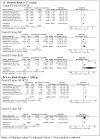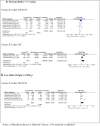Neonatal outcomes in singleton pregnancies conceived by fresh or frozen embryo transfer compared to spontaneous conceptions: a systematic review and meta-analysis
- PMID: 32445067
- PMCID: PMC7266861
- DOI: 10.1007/s00404-020-05593-4
Neonatal outcomes in singleton pregnancies conceived by fresh or frozen embryo transfer compared to spontaneous conceptions: a systematic review and meta-analysis
Abstract
Purpose: The use of assisted reproductive technology (ART) has increased in the last 2 decades and continuous surveillance is needed. This systematic review aims to assess the risk of adverse neonatal outcomes (preterm birth [PTB], low birth weight [LBW], small-for-gestationalage [SGA] and large for gestational-age [LGA]), in singleton pregnancies conceived by fresh or frozen embryo transfer (FET) compared to spontaneous conceptions.
Methods: Cohort studies were identified from MEDLINE, Embase, Cochrane Library (January 2019), and manual search. Meta-analyses were performed to estimate odds ratios (OR) using random effects models in RevMan 5.3 and I-squared (I2) test > 50% was considered as high heterogeneity.
Results: After 3142 titles and abstracts were screened, 1180 full-text articles were assessed, and 14 were eligible. For fresh embryo transfer, the pooled ORs were PTB 1.64 (95% CI 1.46, 1.84); I2 = 97%; LBW 1.67 (95% CI 1.52, 1.85); I2 = 94%; SGA 1.46 [95% CI 1.11, 1.92]; I2 = 99%, LGA 0.88 (95% CI 0.80, 0.87); I2 = 80%). For frozen, the pooled ORs were PTB 1.39 (95% CI 1.34, 1.44); I2 = 0%; LBW 1.38 (95% CI 0.91, 2.09); I2 = 98%; SGA 0.83 (95% CI 0.57, 1.19); I2 = 0%, LGA 1.57 (95% CI 1.48, 1.68); I2 = 22%).
Conclusions: When compared with spontaneous pregnancies, fresh, but not frozen was associated with LBW and SGA. Both fresh and frozen were associated with PTB. Frozen was uniquely associated with LGA. Despite improvements in ART protocols in relation to pregnancy rates, attention is needed towards monitoring adverse neonatal outcomes in these pregnancies.
Keywords: Adverse neonatal outcomes; Assisted reproductive technology; Fresh embryo transfer; Frozen embryo transfer; Meta-analysis; Real-world data.
Conflict of interest statement
The authors declare no competing interests that might have influenced the work described in this manuscript.
Figures





Similar articles
-
Perinatal outcomes of children born after frozen-thawed embryo transfer: a Nordic cohort study from the CoNARTaS group.Hum Reprod. 2013 Sep;28(9):2545-53. doi: 10.1093/humrep/det272. Epub 2013 Jul 5. Hum Reprod. 2013. PMID: 23832793
-
Effect of pre-pregnancy body mass index on neonatal outcomes in women undergoing autologous frozen-thawed embryo transfer.Fertil Steril. 2021 Oct;116(4):1010-1019. doi: 10.1016/j.fertnstert.2021.03.044. Epub 2021 Apr 27. Fertil Steril. 2021. PMID: 33926721
-
Perinatal outcomes of singleton live births with and without vanishing twin following transfer of multiple embryos: analysis of 113 784 singleton live births.Hum Reprod. 2018 Nov 1;33(11):2018-2022. doi: 10.1093/humrep/dey284. Hum Reprod. 2018. PMID: 30219900
-
Obstetric and perinatal outcomes of singleton pregnancies after blastocyst-stage embryo transfer compared with those after cleavage-stage embryo transfer: a systematic review and cumulative meta-analysis.Hum Reprod Update. 2022 Feb 28;28(2):255-281. doi: 10.1093/humupd/dmab042. Hum Reprod Update. 2022. PMID: 34967896
-
Assisted reproductive technology and hypertensive disorders of pregnancy: systematic review and meta-analyses.BMC Pregnancy Childbirth. 2021 Jun 28;21(1):449. doi: 10.1186/s12884-021-03938-8. BMC Pregnancy Childbirth. 2021. PMID: 34182957 Free PMC article.
Cited by
-
Perinatal Outcome of Singletons Born after Using a Simplified Low-Cost IVF Culture System and All Singletons Born in Flanders (Belgium) between 2012 and 2020.J Clin Med. 2023 May 26;12(11):3683. doi: 10.3390/jcm12113683. J Clin Med. 2023. PMID: 37297877 Free PMC article.
-
Assisted Reproductive Technology and Risk of Childhood Cancer Among the Offspring of Parents With Infertility: Systematic Review and Meta-Analysis.JMIR Cancer. 2025 Mar 12;11:e65820. doi: 10.2196/65820. JMIR Cancer. 2025. PMID: 40072918 Free PMC article.
-
Change of HeART: Cardiovascular Implications of Assisted Reproductive Technology.CJC Open. 2023 Sep 15;6(2Part B):142-152. doi: 10.1016/j.cjco.2023.09.008. eCollection 2024 Feb. CJC Open. 2023. PMID: 38487072 Free PMC article. Review.
-
Perinatal Outcomes In Monozygotic Pregnancies Resulting From Assisted Reproductive Technology Procedures: A Single-Center 6-Year Experience Based On A Large Cohort Of Pregnancies.JBRA Assist Reprod. 2023 Mar 30;27(1):29-34. doi: 10.5935/1518-0557.20220014. JBRA Assist Reprod. 2023. PMID: 35575661 Free PMC article.
-
Association of medically assisted reproduction with offspring cord blood DNA methylation across cohorts.Hum Reprod. 2021 Jul 19;36(8):2403-2413. doi: 10.1093/humrep/deab137. Hum Reprod. 2021. PMID: 34136910 Free PMC article.
References
-
- Velez MP, Connolly MP, Kadoch IJ, Phillips S, Bissonnette F. Universal coverage of IVF pays off. Hum Reprod. 2014;29(6):1313–1319. - PubMed
-
- Pinborg A. Short- and long-term outcomes in children born after assisted reproductive technology. BJOG. 2019;126(2):145–148. - PubMed
-
- CDC . National public health action plan for the detection, prevention, and management of infertility. Atlanta: Centers for Disease Control and Prevention; 2014.
-
- European IVFmC, European Society of Human R, Embryology. Calhaz-Jorge C, De Geyter C, Kupka MS, et al. Assisted reproductive technology in Europe, 2013: results generated from European registers by ESHRE. Hum Reprod. 2017;32(10):1957–1973. - PubMed
-
- Zegers-Hochschild F, Schwarze JE, Crosby J, Musri C, Urbina MT, Latin American Network of Assisted R Assisted reproduction techniques in Latin America: the Latin American Registry, 2014. Reprod Biomed Online. 2017;35(3):287–295. - PubMed
Publication types
MeSH terms
Grants and funding
LinkOut - more resources
Full Text Sources
Medical

